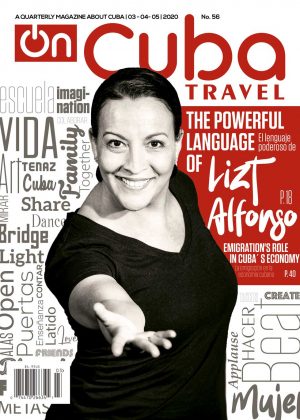Limara Meneses is one of the most important actresses of her generation. For a while she was a very recurrent face in Cuban media. She has been living outside of Cuba for a few years and has been not inactive per se, but a bit distanced from acting, for a good reason: motherhood. She has two daughters and is expecting a third, to be named Isabella. She expresses her great acting potential and qualities on the set, although she has also worked behind the scenes.
A graduate of the Higher Institute of Art (ISA), she has worked with great filmmakers such as Fernando Trueba in Chico y Rita, about the life of Bebo Valdés. She has “a pact” with music, because almost all of the characters she plays are linked to the stage and to our musical heritage. I met Limara before her film debut, when we were studying at the same high school. Then we met again at the Cuban Institute of Cinematographic Art and Industry, when I was writing about the film she starred in, El Benny. Today, thanks to technology we meet again to talk about her career: she in Atlanta and me in Havana.
“Jorge Luis Sánchez gave me the opportunity to give a 400-degree turn to my life. El Benny is well-remembered in and outside of Cuba and my character, Aida, was also beloved. I still receive beautiful messages. I remember the experience with joy and a lot of nostalgia, almost 15 years ago when I was 17. Imagine.”
After so much time, how do you see Aida, that character that catapulted you?
Oh, wow, time passes so quickly. I always say that the role marked a before and after in my life. It was the discovery of a profession that I had never considered before. Aida represented the trust of a lot of people, starting with the director Jorge Luis Sánchez, producer Ihojamil Navarro, and the technical production team. In the case of Jorge Luis, he was putting his debut in the hands of someone who came from the countryside, with no knowledge of acting or cinema. I became Aida (Benny’s wife). Honestly, I’m not yet fully aware of everything that I owe to Aida, I’m convinced that much or almost everything that came later in my life is thanks to her.
It has been said that you have a pact with music. Many of your successful roles have been linked to this exciting universe. Tell us about this harmonious relationship.
My most transcendental characters in film have had to do with the world of the stage: feature films or shorts related to music. There’s an element of mystery in my life tying cinema to music, and also to Mario Guerra, a great friend and actor with whom I always find myself in films, specifically in this genre. Our harmony is apparent. El Benny threw me into the world of film; Oda a la Piña was a successful short film that was at many important festivals, one of them was the Küstendorf Film and Music Festival organized by Emir Kusturica. The same thing happened with Chico y Rita, for which we received a Goya and an Oscar nomination. We could be talking for a long time about this mysterious and beautiful relationship I have with the world of music in film. I should consider taking singing lessons, don’t you think?
What have been the biggest challenges you faced in your career?
Exposing my nude body, and the moment when I decided to create my family.
How do you take on the role of mother, immigrant, and professional?
Being a mother is really complex for me, especially since I became one too early. I have yet to find the idyllic part of being a mother [laughing], though I respect those who see it as something magical. I feel it’s a complex struggle and a clash of tremendous emotions. Maybe I see it this way because of being an immigrant: I’m alone, without family nearby. Although I have a lot of support from my in-laws when they come to visit, from my father indulging his grandchildren’s whims, and from my mom. We’re all scattered around the world, you can imagine…. To continue, or at least, try to continue with my profession, a lot of it is a labor of love, because here I have to pay childcare in order to participate in the theatrical process.
Let’s talk about techniques, tactics, and strategies. How do you get into your characters? And how do you manage to detach yourself after interpreting them?
If you see my scripts someday, you’d go crazy, sometimes I don’t even understand myself. I start working on the character from the moment I go to casting, I write everything that comes to my mind as I begin to observe, listen, and think like the character. I read the scripts over and over. Everything I studied at the ISA has helped me a lot —Uta Hagen, Lee Strasberg, Stanislavski, Eugenio Barba—, although it seems that they’re all from the theater, when I take from each one what helps me, I create my own technique and, most importantly, I work with my emotions. When you work with emotions, obviously there will be specific moments when something will affect you, or vice versa…. It’s not all about suffering! But up to now I don’t usually stay attached to anything beyond what’s normal. I have my own life and that’s the one I have to live.
What must a good actor be made of? What can’t be lacking?
Courage, humility, and honesty. I say those three because one is not enough to be an actor. Whether it’s good or bad, I’m not the one to decide. But for anyone who’s an actor or decides to be an actor, I think it’s very beautiful that they have one of these qualities.
Marlon Brandon once said that he resented those people who, when they met an actor, thought they were facing a stupid celebrity who wasn’t interested in normal things like the rest of us. What do you think of the link between an actor and everyone else?
I think that people are free to think what they want about others until they’ve had the chance to meet them. I believe that the bond between human beings and with everything surrounding them should be cordial and respectful. It doesn’t matter if they’re actors, doctors, architects, or astronauts.
How did Cuatro mujeres —the successful play you wrote and acted in— come about?
Cuatro mujeres was a project that arose from a collective need to make theater, from me and three other actresses here. It was really written, produced, and directed among the four of us, along with Ona Gutiérrez. We were able to take the play to Mexico and then put it on again twice here in Atlanta, which is a complex market for our theatrical concept. But all eight shows here were very successful, which led me to a bigger project for next year.
How are you able to not be typecast, which has happened to many actresses?
Do you know why I haven’t played many more characters? Precisely because of the damn stereotype. In life you have to know how to say NO, even if that means working as a cashier in a supermarket or earning a living by studying something else that is financially viable, when you can’t practice your profession.
How have you experienced being an Afro-Cuban actress in the United States?
I’m Afro-Cuban and of other mixed descent as well. In the United States, there’s a strong history of Afro-descendants. I live in the South, in Atlanta. So far, I haven’t felt that being Afro-Cuban or Afro-Latin, black, mulatto, or whatever they want to call me, has affected me for better or worse. Not even for selecting which castings to go to. My agency sends me to all the castings that fit my profile; sometimes they ask for blacks, sometimes they only need to speak good Spanish. I’ve really integrated very well to this city; I feel like just another resident. It’s my experience, I think, that when a director likes you, labels don’t matter.
You’re also a producer. Tell me about that other aspect, that way of living art beyond the cameras?
Being a “producer” is a big word. I like to negotiate, I like money, I love processes in full development. But what I like the most is feeling like I’m doing things that motivate me. That’s how I started looking for clients so that, like in the case of Cuatro mujeres, I could appear in theatrical spaces. Then I had an idea and I made several proposals to develop an artistic movement with a club here. And from there I had the possibility, with my husband, to direct and produce something that was more in the developmental phase. With that financial support, I started directing and producing, and we created a company so that every time I was going stir crazy, I wouldn’t have to wait to be called for work. To know that I have something of my own that I can do whenever I want…. We’ve already completed the first project, the play ¿Quién le teme al mundo de Santa? (Who’s Afraid of Santa’s World?).
Will you act again in Cuba?
Without a doubt. It’s one of my greatest wishes. But it seems more and more distant all the time. It would have to be someone who wants to have me in their project, or I could spend a while there and try to become integrated once again, which seems difficult. There’s also a new generation working hard, with very good actors and actresses. I see it as a remote possibility, but not impossible. The answer is an emphatic YES. It’s a repressed desire of mine.
What Cuban directors would you like to work with?
I would like to work with Jorge Luis Sánchez, Hugo Reyes, and with Daranas, I haven’t forgotten the way he treated me in one of his castings. I never had the opportunity to work with Fernando Pérez, and I’m also very curious about working with Pavel Giroud, Carlos Celdrán, and Raúl Martín. But I’d be happy to work with whoever wants to have me in their project, and if it’s in Cuba, all the better.
Let’s talk about the future. After you have the baby, what’s next?
After Isabella is born: recover. Find a space and contact my agency to go back to castings. And I have a seminar at an important university here, Kennesaw University. They have a program where they always show Chico y Rita, and they met me at Cuatro mujeres. Well, as a result of that seminar, we’re going to start a nice project with theatrical exchange, cinema, etc. And I’ll continue with my two workshop series at Emory University, another university here, which has a theater department and I’ll collaborate with a class.





